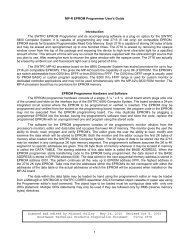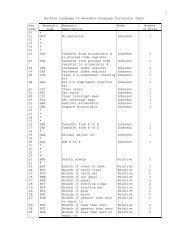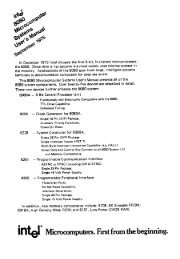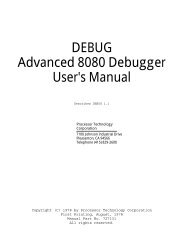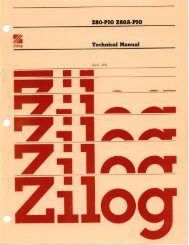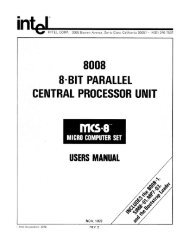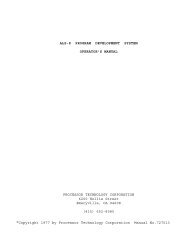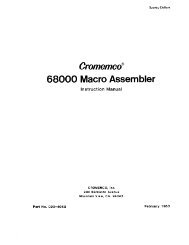The System Manual of SOL-20 - History of Computers
The System Manual of SOL-20 - History of Computers
The System Manual of SOL-20 - History of Computers
You also want an ePaper? Increase the reach of your titles
YUMPU automatically turns print PDFs into web optimized ePapers that Google loves.
PROCESSOR TECHNOLOGY CORPORATION<br />
Sol THEORY OF OPERATION<br />
SECTION VIII<br />
the light is optically coupled to the base <strong>of</strong> a photo transistor in<br />
U39 to cause the transistor to conduct. Conduction translates to a<br />
low, or mark, level at the input (pin 13) <strong>of</strong> U38. Since both the<br />
current loop and RS-232 received data (SLR1/SLR2 and SRD respectively)<br />
share the input to U38, both should not be used simultaneously.<br />
<strong>The</strong>re are five external control signals in the RS-232 section<br />
<strong>of</strong> the SDI/UART: two are sent to the external device (SRTS and SDTR),<br />
and three are received from the device (SCTS, SCD and SDSR).<br />
SRTS on pin 4 <strong>of</strong> J1 was discussed earlier. SDTR (serial data<br />
terminal ready) is simply tied to +12 V dc through R24. This indicates<br />
to the external device that Sol is connected to it.<br />
SCTS (serial clear to send), SCD (serial carrier detect) and<br />
SDSR (serial data set ready) indicate status <strong>of</strong> the external device.<br />
<strong>The</strong>y enter Sol on pins 5, 8 and 6 <strong>of</strong> J1 respectively, and all three<br />
are active high. Following level conversion and inversion in line receivers<br />
U38, data on these lines is gated through noninverting tristate<br />
buffers U37 to the Internal Data Bus when !PORT_IN_F8 is active.<br />
!PORT_IN_F8 also enables five bits <strong>of</strong> UART status to be reported<br />
over the Internal Data Bus. <strong>The</strong>se are PE, FE, OE, DR and TBRE<br />
on pins 13, 14, 15, 19 and 22 respectively <strong>of</strong> the UART. <strong>The</strong>y are defined<br />
as follows:<br />
PE:<br />
FE:<br />
OE:<br />
DR:<br />
Parity Error--received parity does not compare to<br />
that programmed. (Bit INT2)<br />
Framing Error--valid stop bit not received when<br />
expected. (Bit INT3)<br />
Overrun Error--CPU did not accept data before it<br />
was replaced with additional data. (Bit INT4)<br />
Data Ready--data received by UART is available<br />
when requested. (Bit INT6)<br />
TBRE: Transmitter Buffer Register Empty--UART is ready<br />
to accept another word from the Bidirectional<br />
Data Bus. (Bit INT7)<br />
8.5.4 Display Section<br />
An understanding <strong>of</strong> how characters are formed on the video<br />
monitor will help you follow operation <strong>of</strong> the display section.<br />
<strong>The</strong> monitor screen can be thought <strong>of</strong> as a large matrix <strong>of</strong><br />
small light elements, or dots, that can be turned on and <strong>of</strong>f. In<br />
this context the overall video presentation consists <strong>of</strong> light and<br />
dark dots.<br />
VIII-22



